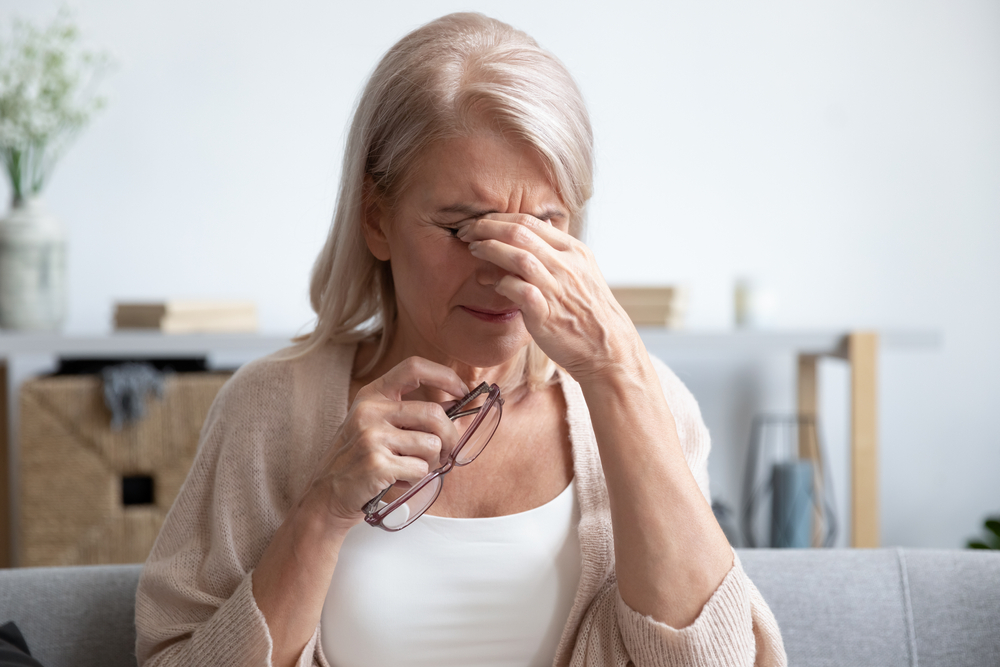With evidence suggesting that menopause reduces gut diversity and increases the risk of metabolic disease, moving to a diet composed of low inflammatory functional foods offers potential to help mitigate dry eye disease in a post-menopausal population.
Some chronic disease can be considered a physiological response to excesses of modern living, with the most prevalent behaviour risk factors in Australia being smoking, alcohol use, a diet high in red meat and low in whole grains, and occupational asbestos exposure (here). The Australian Bureau of Statistics reports that 46.6% of Australians live with one or more chronic disease (here), and these conditions can now be considered an epidemic (here).
An often-under-reported condition that is commonly comorbid with chronic disorders (particularly autoimmune diseases) is dry eye (here). Typified by ocular irritation, discomfort and disturbed vision, dry eye disease can significantly reduce work and social participation with a concomitant reduction in overall quality of life (here). This disorder disproportionately affects women and, further, post-menopausal women (here).
The recent Tear Film and Ocular Society (TFOS) Lifestyle Workshop (2023) was convened to raise awareness of the potential impact of lifestyle factors on ocular surface health, particularly dry eye disease. As a result of the workshop, there is growing research interest in teasing out associations between lifestyle, ocular surface disease and the human microbiome as we age, and, particularly, as women reach menopause (when the prevalence of dry eye increases) (here).

Drawing from the explosion of interest (here) in how our gut microbiome influences chronic inflammation and disease, and reports suggesting that menopause is associated with lower gut microbiome diversity, my area of research focuses on how gut dysbiosis (deleterious perturbation of the microbiome community) is influenced by age and lifestyle and, in turn, influences the development and course of dry eye disease. With this knowledge, we can further investigate how modifying our lifestyle might improve signs and symptoms of dry eye in a post-menopausal population.
We know that menopause-induced oestrogen deficiency causes disruption to both gut and vaginal microecology, which, in turn, can disrupt the mucosal surfaces of each (here). Similarly, ocular microbiome changes in response to reduced hormones can lead to changes in the conjunctival and corneal mucosa, predisposing women to autoimmune, allergic and inflammatory ocular diseases, including dry eye disease (here).
If we view dry eye disease as a chronic inflammatory disease, then we can begin to translate established understanding of other such inflammatory disorders to ameliorating the signs and symptoms of dry eye. We know that changes in the gut microbiome due to oestrogen deficiency influence the development of obesity and metabolic disorders during menopause (here). Therefore, targeting the gut microbiome through diet and exercise is a tantalising opportunity for therapeutic intervention as part of a holistic approach to dry eye disease.
Recent studies have demonstrated the efficacy of probiotics (live or attenuated bacteria that reduce gut dysbiosis and immunogenic response) and isoflavones (or phytoestrogens; plant-based products that mimic estrogens) in reducing menopause-induced obesity and lowering the prevalence of metabolic syndrome (here). Further work (here) is exploring the concept of the estrobolome — the collection of gut bacterial gene products that metabolise oestrogens, with particular interest in the metabolism of diet-derived phytoestrogens.
The estrobolome has been shown to be influenced by exercise as well as diet (here). Of interest to dry eye research, a study involving participants with metabolic syndrome who moved to a Mediterranean diet and increased their exercise showed improvement in dry eye disease (here). The Mediterranean diet group showed improvement, but there was further improvement in the group who undertook exercise and reduced their overall calorie intake. All of this suggests reduced dry eye signs and symptoms are associated with a concomitant reduction in systemic inflammation which can be influenced by lifestyle.
With the limited success of available dry eye therapeutics, we have a great opportunity to take control of diet as a vital route for immune system modulation. Knowledge of the therapeutic role of fermented food products can be traced back 10 000 years (here). With modern techniques we are merely documenting what our ancestors have known for generations. A pro-inflammatory diet such as the typical Western diet reduces gut microbial diversity while an anti-inflammatory diet such as the Mediterranean diet is associated with increased diversity and a high proportion of probiotic bacteria (here). With evidence suggesting that menopause reduces gut diversity and increases the risk of metabolic disease (here), moving to a diet composed of low inflammatory functional foods offers potential to help mitigate dry eye disease in a post-menopausal population.
In one of the first studies to explore the use of oral prebiotics and probiotics for dry eye disease, we recently conducted a double-blind placebo-controlled clinical trial in a population with moderate disease (here). For ethical reasons we excluded those with other inflammatory disorders but even within this constrained population we observed improvements in dry eye signs and symptoms following probiotic use compared with placebo. Other studies (here and here) have similarly reported promising indications that both exercise and diet can improve dry eye, through perturbation of the gut bacterial community to a lower inflammatory state.
Although numerous animal studies (here) indicate targeting of the gut microbiome as a promising therapeutic option for dry eye disease, further clinical trials directly targeting the gut microbiome in post-menopausal women are needed to give a better understanding of how clinicians can empower their patients in taking control of their dry eye disease.
As humans deduced 10 000 years ago, functional foods make for a diverse gut microbiome that affects our overall health and quality of life. With the idea that “everything old is new again”, our research, and that of our colleagues, is hopefully reminding us of these ancient wisdoms.
Dr Judith Flanagan is Adjunct Associate Professor in the School of Optometry and Vision Science, University of New South Wales.
The statements or opinions expressed in this article reflect the views of the authors and do not necessarily represent the official policy of the AMA, the MJA or InSight+ unless so stated.
Subscribe to the free InSight+ weekly newsletter here. It is available to all readers, not just registered medical practitioners.
If you would like to submit an article for consideration, send a Word version to mjainsight-editor@ampco.com.au.

 more_vert
more_vert
Suggest certain pharmaceuticals may be a significant cause of dry eye disease in older women.
Fascinating article and interesting link to the gut . Thank you .